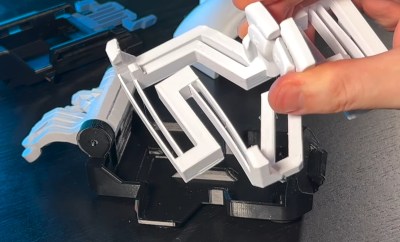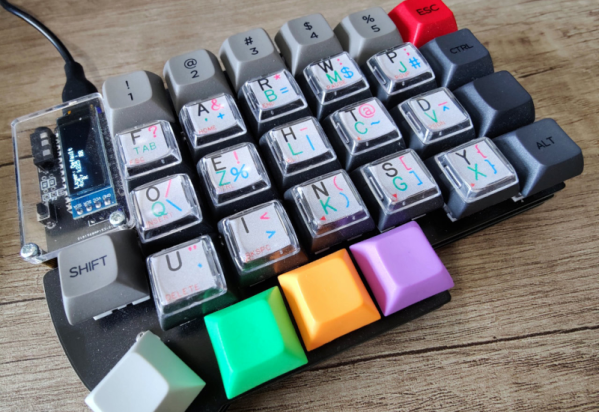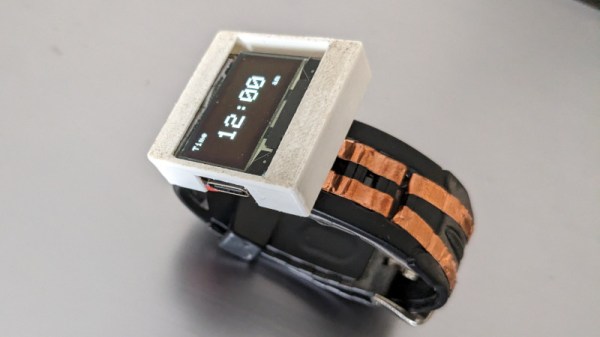After having been involved in an accident, [Kurt Kohlstedt] suffered peripheral neuropathy due to severe damage to his right brachial plexus — the network of nerves that ultimately control the shoulder, arm, and hand. This resulted in numbness and paralysis in his right shoulder and arm, with the prognosis being a partial recovery at best. As a writer, this meant facing the most visceral fear possible of writing long-form content no longer being possible. While searching for solutions, [Kurt] looked at various options, including speech-to-text (STT), before focusing on single-handed keyboard options. Continue reading “Adaptive Keyboards & Writing Technologies For One-Handed Users”
accessibility52 Articles
Haptic Displays Bring Sports To The Vision Impaired
When it comes to the majority of sports broadcasting, it’s all about the visual. The commentators call the plays, of course, but everything you’re being shown at home is on a screen. Similarly, if you’re in the stadium, it’s all about getting the best possible view from the best seats in the house.
Ultimately, the action can be a little harder to follow for the vision impaired. However, one company is working hard to make sports more accessible to everyone. Enter OneCourt, and their haptic sports display technology.
Continue reading “Haptic Displays Bring Sports To The Vision Impaired”
An Electric Skateboard For The Dogs
What’s a dog to do if they want to do some accessible skateboarding? [Simone Giertz]’s three-legged pup, [Scraps], got the chance to try a LEGO Technic board for her thrills.
This electric LEGO skateboard features six motors and paw pedals to let [Scraps] steer while [Giertz] remotely controls the speed of the board. While it’s not a particularly fast ride, it does let [Scraps] live out her dreams of being a YouTube dog skateboard celebrity.
A video from [Giertz] wouldn’t be complete without a life lesson, and this time it was the importance of rest to the creative process. Sometimes when a solution eludes you, it’s just time to take a break. The steering mechanism, in particular, was giving her trouble but became simple the next morning. We’re also treated to an adorable shot of [Scraps] napping when the initial shoot of her riding the board wasn’t going as planned.
Want to try your hand at making your own skateboard? How about a deck from recycled plastic, tank treads instead of wheels, or is a rocket-powered skateboard more your speed?
3D Printed Braille Trainer Reduces Barrier To Entry
Accessibility devices are a wonder of modern technology, allowing people with various needs to interact more easily with the world. From prosthetics to devices to augment or aid someone’s vision or hearing, devices like these can open up many more opportunities than would otherwise exist. A major problem with a wide array of these tools is that they can cost a fortune. [3D Printy] hoped to bring the cost down for Braille trainers which can often cost around $1000.
Braille trainers consist of a set of characters, each with six pins or buttons that can be depressed to form the various symbols used in the Braille system. [3D Printy]’s version originally included six buttons, each with a set of springs, that would be able to pop up and down. After some work and real-world use, though, he found that his device was too cumbersome to be effective and redesigned the entire mechanism around flexible TPU filament, allowing him to ditch the springs in favor of indentations and buttons that snap into place without a dedicated spring mechanism.
The new design is modular, allowing many units to be connected to form longer trainers than just a single character. He’s also released his design under the Creative Commons public domain license, allowing anyone to make and distribute these tools as they see fit. The design also achieves his goal of dramatically reducing the price of these tools to essentially just the cost of filament, provided you have access to a 3D printer of some sort. If you need to translate some Braille writing and don’t want to take the time to learn this system, take a look at this robotic Braille reader instead.
Thanks to [George] for the tip!
Continue reading “3D Printed Braille Trainer Reduces Barrier To Entry”
Not A FrogPad But Close
While you might think one-handed keyboards are a niche item, if you have reduced function in one hand or you only have one hand, they are pretty important. [Kian] was getting ready for surgery that would put his left arm out of commission for a while, which spurred the construction of a one-handed keyboard inspired by FrogPad.
There was a time when creating a new keyboard would have been a significant task. These days, it is reasonably easy and [Kian] simply repurposed an existing kit for a split keyboard. Using just half the board was easy since it is made in two parts already.
There have been many attempts at building effective one-handed input devices over the years, and the circa 2002 FrogPad is one of the better devices. Like most one-handed keyboards, it uses layers. The top layer has the most common keystrokes to minimize the number of layer changes required to type common text.
Squid-Con Brings Joy To All
While we’re always happy to see accessibility aids come into fruition, most of them focus on daily tasks, not that there’s anything wrong with that. But what about having some fun? That’s the idea behind [Akaki Kuumeri]’s accessibly-awesome Joy-Con controller, the Squid-Con, which provides access to every button with just one hand. It even has tripod and AMPS mounts.
 The joysticks themselves are controlled with the thumb and pinky, although some of [Akaki]’s beta testers changed it up a bit. That’s okay, because it’s designed to be comfortable in a variety of positions for either hand. As for the ABXY buttons, those are actuated using 3D-printed arms that connect to a central piece which [Akaki] calls the turbine.
The joysticks themselves are controlled with the thumb and pinky, although some of [Akaki]’s beta testers changed it up a bit. That’s okay, because it’s designed to be comfortable in a variety of positions for either hand. As for the ABXY buttons, those are actuated using 3D-printed arms that connect to a central piece which [Akaki] calls the turbine.
But perhaps the coolest part of this project is the flexures that actuate the shoulder buttons (L, R, zL, and zR) on the controllers. It’s a series of four arms that are actuated by bringing the fingers back toward the palm. If all of this sounds confusing, just check out the video after the break.
We love flexures around here, and we’ve seen them in everything from cat feeding calendars to 6-DOF positioners to completely new kinds of joysticks.
Watch Hides Gesture Controls In Wristband
Over the last five to ten years, smart watches have become fairly ubiquitous, with the Apple Watch being among the most prominent of them. Not everyone wants or needs all of the capabilities of these devices, though; plenty are still opting for simpler devices which only have a few functions built into them. [Josh] has been working on one of these devices but takes a major design cue from their smart counterparts with the addition of gesture controls for the watch built into the wristband instead of relying on a more traditional button interface.
The watch hosts most of the functionality of a non-smart digital watch, with a timer, alarms, and a stop watch built-in. To change the time or access any of these functions, a combination of resistive and capacitive touch sensors are built into the wristband near the watch face. The combination of sensors aims to use the benefits of either type of sensor, with the capacitive sensors being used for precision and gesture recognition and the resistive sensors being used for pressure sensitivity. Placing these sensors in the band instead of the watch face improves visibility as well, since the screen won’t be obscured by the user touching the screen.
[Josh] originally intended this type of watch to be used for those with prosthetics or other disabilities which would limit the ability to use standard watch buttons or interact with a touch screen on the watch face itself. The device is working quite well as can be seen in the video linked below, but is still in the prototyping phase and under active development. For finishing up the final versions, we’d recommend taking a look at the design of these open-source smart watches for their high quality fit and finish.
Continue reading “Watch Hides Gesture Controls In Wristband”


















